Adolf Hitler
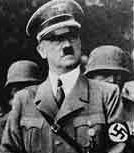
(1889 - 1945)
Adolf Hitler (1889-1945) was the founder and leader of the Nazi
Party and the most influential voice in the organization, implementation and execution of the Holocaust, the systematic extermination and ethnic cleansing of six million European Jews and millions of other non-aryans.
Hitler was the Head of State, Supreme Commander of the Armed Forces and guiding spirit, or fuhrer, of Germany's Third Reich from
1933 to 1945.
- Hitler's Early Years
- World War I
- Hitler Starts to Lead
- Rise of the Nazi Party
- Hitler As German Fuhrer
- World War II
- Allied Victory & Hitler's Death
Early Years
Born
in Braunau am Inn, Austria, on April 20, 1889, Hitler was the son of a fifty-two-year-old
Austrian customs official, Alois
Schickelgruber Hitler, and his third wife, a young peasant girl,
Klara Poelzl, both from the backwoods of lower Austria. The young Hitler
was a resentful, discontented child. Moody, lazy, of unstable temperament,
he was deeply hostile towards his strict, authoritarian father and strongly
attached to his indulgent, hard-working mother, whose death from cancer
in December 1908 was a shattering blow to the adolescent Hitler.
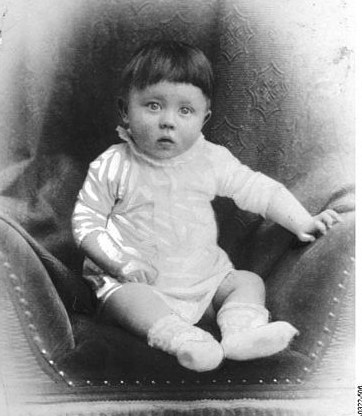 Hitler as a baby
Hitler as a baby |
After spending four years in the Realschule in Linz,
he left school at the age of sixteen with dreams of becoming a painter.
In October 1907, the provincial, middle-class boy left home for Vienna,
where he was to remain until 1913 leading a bohemian, vagabond existence.
Embittered at his rejection by the Viennese Academy of Fine Arts, he
was to spend "five years of misery and woe" in Vienna as he
later recalled, adopting a view of life which changed very little in
the ensuing years, shaped as it was by a pathological hatred of Jews
and Marxists, liberalism and the cosmopolitan Habsburg monarchy.
Existing from hand to mouth on occasional odd jobs and
the hawking of sketches in low taverns, the young Hitler compensated for
the frustrations of a lonely bachelor's life in miserable male hostels by
political harangues in cheap cafes to anyone who would listen and indulging
in grandiose dreams of a Greater Germany.
In Vienna he acquired his first education in politics by studying
the demagogic techniques of the popular Christian-social Mayor, Karl
Lueger, and picked up the stereotyped, obsessive anti-Semitism with its brutal, violent sexual connotations and concern
with the "purity of blood" that remained with him to the end
of his career. From crackpot racial theorists like the defrocked monk,
Lanz von Liebenfels, and the Austrian Pan-German leader, Georg von Schoenerer,
the young Hitler learned to discern in the "Eternal Jew" the
symbol and cause of all chaos, corruption and destruction in culture,
politics and the economy. The press, prostitution, syphilis, capitalism,
Marxism, democracy and pacifism--all were so many means which "the
Jew" exploited in his conspiracy to undermine the German nation
and the purity of the creative Aryan race.
World War I
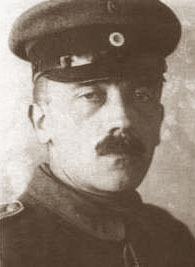 Hitler during World War 1 (c.1915)
Hitler during World War 1 (c.1915) |
In May 1913 Hitler left Vienna for Munich and, when war
broke out in August 1914, he joined the Sixteenth Bavarian Infantry
Regiment, serving as a despatch runner. Hitler proved an able, courageous
soldier, receiving the Iron Cross (First Class) for bravery, but did not
rise above the rank of Lance Corporal. Twice wounded, he was badly gassed
four weeks before the end of the war and spent three months recuperating in
a hospital in Pomerania. Temporarily blinded and driven to impotent rage by
the abortive November 1918 revolution in Germany as well as the military
defeat, Hitler, once restored, was convinced that fate had chosen him to
rescue a humiliated nation from the shackles of the Versailles Treaty, from
Bolsheviks and Jews.
Assigned by the Reichswehr in the summer of 1919 to
"educational" duties which consisted largely of spying on
political parties in the overheated atmosphere of post-revolutionary
Munich, Hitler was sent to investigate a small nationalistic group of
idealists, the German Workers' Party. On 16 September 1919 he entered the
Party (which had approximately forty members), soon changed its name to the
National Socialist German Workers' Party (NSDAP) and had imposed himself as
its Chairman by July 1921.
Hitler Becomes a Leader
Hitler discovered a powerful talent for oratory as
well as giving the new Party its symbol — the swastika — and its greeting "Heil!." His hoarse, grating
voice, for all the bombastic, humourless, histrionic content of his
speeches, dominated audiences by dint of his tone of impassioned conviction
and gift for self-dramatization. By November 1921 Hitler was recognized
as Fuhrer of a movement which had 3,000 members, and boosted his personal
power by organizing strong- arm squads to keep order at his meetings
and break up those of his opponents. Out of these squads grew the storm
troopers (SA) organized by Captain Ernst
Röhm and Hitler's black-shirted personal bodyguard, the Schutzstaffel (SS).
Hitler focused his propaganda against the Versailles
Treaty, the "November criminals," the Marxists and the visible,
internal enemy No. 1, the "Jew," who was responsible for all
Germany's domestic problems. In the twenty-five-point programme of the
NSDAP announced on 24 February 1920, the exclusion of the Jews from the
Volk community, the myth of Aryan race supremacy and extreme nationalism
were combined with "socialistic" ideas of profit-sharing and
nationalization inspired by ideologues like Gottfried Feder. Hitler's first
written utterance on political questions dating from this period emphasized
that what he called "the anti-Semitism of reason" must lead
"to the systematic combating and elimination of Jewish privileges. Its
ultimate goal must implacably be the total removal of the Jews."
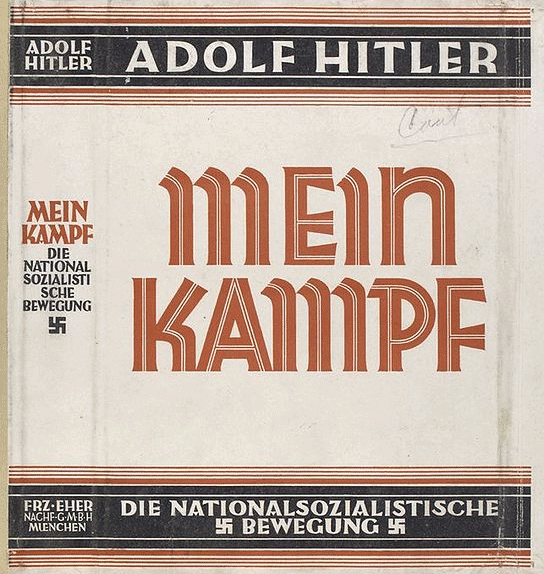 Cover of Hitler's treatise - Mein Kampf
Cover of Hitler's treatise - Mein Kampf |
By November 1923 Hitler was convinced that the Weimar
Republic was on the verge of collapse and, together with General Ludendorff
and local nationalist groups, sought to overthrow the Bavarian government
in Munich. Bursting into a beer-hall in Munich and firing his pistol
into the ceiling, he shouted out that he was heading a new provisional
government which would carry through a revolution against "Red
Berlin." Hitler and Ludendorff then marched through Munich at the
head of 3,000 men, only to be met by police fire which left sixteen
dead and brought the attempted putsch to an ignominious end. Hitler
was arrested and tried on 26 February 1924, succeeding in turning the
tables on his accusers with a confident, propagandist speech which ended
with the prophecy: "Pronounce us guilty a thousand times over:
the goddess of the eternal court of history will smile and tear to pieces
the State Prosecutor's submission and the court's verdict for she acquits
us." Sentenced to five years' imprisonment in Landsberg fortress,
Hitler was released after only nine months during which he dictated Mein Kampf (My Struggle)
to his loyal follower, Rudolf
Hess. Subsequently the "bible" of the Nazi Party, this
crude, half-baked hotchpotch of primitive Social Darwinism, racial myth,
anti-Semitism and lebensraum fantasy had sold over five million copies
by 1939 and been translated into eleven languages.
The failure of the Beer-Hall
putsch and his period of imprisonment transformed Hitler from an
incompetent adventurer into a shrewd political tactician, who henceforth
decided that he would never again confront the gun barrels of army and
police until they were under his command. He concluded that the road
to power lay not through force alone but through legal subversion of
the Weimar Constitution, the building of a mass movement and the combination
of parliamentary strength with extra-parliamentary street terror and
intimidation. Helped by Goering and Goebbels he began to reassemble his
followers and rebuild the movement which had disintegrated in his absence.
Rise of the Nazi Party
In January 1925 the ban on the Nazi Party was removed
and Hitler regained permission to speak in public. Outmaneuvering the
"socialist" North German wing of the Party under Gregor Strasser,
Hitler re-established himself in 1926 as the ultimate arbiter to whom all
factions appealed in an ideologically and socially heterogeneous movement.
Avoiding rigid, programmatic definitions of National Socialism which would
have undermined the charismatic nature of his legitimacy and his claim to
absolute leadership, Hitler succeeded in extending his appeal beyond
Bavaria and attracting both Right and Left to his movement.
Though the Nazi Party won only twelve seats in the 1928
elections, the onset of the Great Depression with its devastating effects
on the middle classes helped Hitler to win over all those strata in German
society who felt their economic existence was threatened. In addition to
peasants, artisans, craftsmen, traders, small businessmen, ex-officers,
students and declasse intellectuals, the Nazis in 1929 began to win over
the big industrialists, nationalist conservatives and army circles. With
the backing of the press tycoon, Alfred Hugenberg, Hitler received a
tremendous nationwide exposure just as the effects of the world economic
crisis hit Germany, producing mass unemployment, social dissolution, fear
and indignation. With demagogic virtuosity, Hitler played on national
resentments, feelings of revolt and the desire for strong leadership using
all the most modern techniques of mass persuasion to present himself as
Germany's redeemer and messianic saviour.
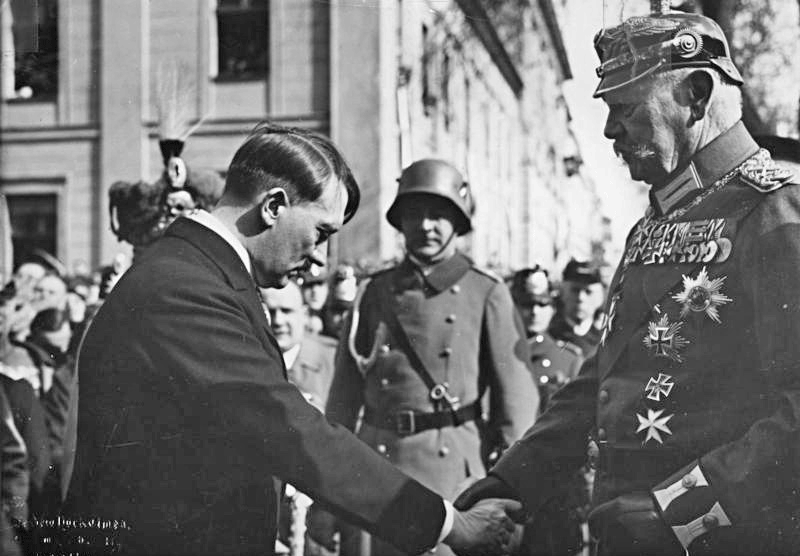 Hitler and President von Hindenburg (1933)
Hitler and President von Hindenburg (1933) |
In the 1930 elections the Nazi vote jumped dramatically
from 810,000 to 6,409,000 (18.3 percent of the total vote) and they
received 107 seats in the Reichstag. Prompted by Hjalmar
Schacht and Fritz Thyssen, the great industrial magnates began to
contribute liberally to the coffers of the NSDAP, reassured by Hitler's
performance before the Industrial Club in Dusseldorf on 27 January 1932
that they had nothing to fear from the radicals in the Party. The following
month Hitler officially acquired German citizenship and decided to run
for the Presidency, receiving 13,418,011 votes in the run-off elections
of 10 April 1931 as against 19,359,650 votes for the victorious von
Hindenburg , but four times the vote for the communist candidate, Ernst
Thaelmann. In the Reichstag elections of July 1932 the Nazis emerged
as the largest political party in Germany, obtaining nearly fourteen
million votes (37.3 per cent) and 230 seats. Although the NSDAP fell
back in November 1932 to eleven million votes (196 seats), Hitler was
helped to power by a camarilla of conservative politicians led by Franz
von Papen, who persuaded the reluctant von Hindenburg to nominate
"the Bohemian corporal" as Reich Chancellor on 30 January
1933.
Once in the saddle, Hitler moved with great speed to
outmanoeuvre his rivals, virtually ousting the conservatives from any real
participation in government by July 1933, abolishing the free trade unions,
eliminating the communists, Social Democrats and Jews from any role in
political life and sweeping opponents into concentration camps. The
Reichstag fire of 27 February 1933 had provided him with the perfect
pretext to begin consolidating the foundations of a totalitarian one-party
State, and special "enabling laws" were ramrodded through the
Reichstag to legalize the regime's intimidatory tactics.
With support from the nationalists, Hitler gained a
majority at the last "democratic" elections held in Germany on 5
March 1933 and with cynical skill he used the whole gamut of persuasion,
propaganda, terror and intimidation to secure his hold on power. The
seductive notions of "National Awakening" and a "Legal
Revolution" helped paralyse potential opposition and disguise the
reality of autocratic power behind a facade of traditional institutions.
Hitler As Fuhrer
 Hitler after an SS rally in Berlin
Hitler after an SS rally in Berlin |
The destruction of the radical SA leadership under Ernst
Rohm in the Blood Purge of June 1934 confirmed Hitler as undisputed
dictator of the Third Reich and by the beginning of August, when he
united the positions of Fuhrer and Chancellor on the death of von Hindenburg,
he had all the powers of State in his hands. Avoiding any institutionalization
of authority and status which could challenge his own undisputed position
as supreme arbiter, Hitler allowed subordinates like Himmler, Goering and Goebbels to mark out their own domains
of arbitrary power while multiplying and duplicating offices to a bewildering
degree.
During the next four years Hitler enjoyed a dazzling string
of domestic and international successes, outwitting rival political
leaders abroad just as he had defeated his opposition at home. In 1935
he abandoned the Versailles Treaty and began to build up the army by
conscripting five times its permitted number. He persuaded Great Britain
to allow an increase in the naval building programme and in March 1936
he occupied the demilitarized Rhineland without meeting opposition.
He began building up the Luftwaffe and supplied military aid to Francoist
forces in Spain, which brought
about the Spanish fascist victory in 1939.
The German rearmament programme led to full employment
and an unrestrained expansion of production, which reinforced by his
foreign policy successes--the Rome-Berlin pact of 1936, the Anschluss
with Austria and the "liberation" of the Sudeten Germans in
1938 — brought Hitler to the zenith of his popularity. In February
1938 he dismissed sixteen senior generals and took personal command
of the armed forces, thus ensuring that he would be able to implement
his aggressive designs.
Hitler's saber-rattling tactics bludgeoned the British
and French into the humiliating Munich agreement of 1938 and the eventual
dismantlement of the Czechoslovakian State in March 1939. The concentration camps, the Nuremberg racial
laws against the Jews, the persecution of the churches and political
dissidents were forgotten by many Germans in the euphoria of Hitler's
territorial expansion and bloodless victories. The next designated target
for Hitler's ambitions was Poland (her independence guaranteed by Britain and France) and, to avoid
a two-front war, the Nazi dictator signed a pact of friendship and non-aggression
with Soviet Russia.
World War II
On September 1, 1939, German armed forces invaded Poland
and henceforth Hitler's main energies were devoted to the conduct of a war
he had unleashed to dominate Europe and secure Germany's "living
space."
The first phase of World War II was dominated by German
Blitzkrieg tactics: sudden shock attacks against airfields, communications,
military installations, using fast mobile armor and infantry to follow
up on the first wave of bomber and fighter aircraft. Poland was overrun
in less than one month, Denmark and Norway in two months, Holland, Belgium, Luxemburg and France in six weeks. After the fall of France in June 1940 only Great Britain
stood firm.
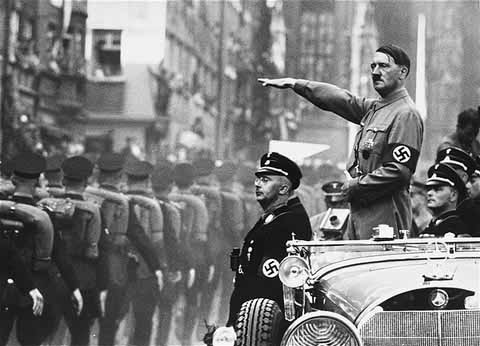 Hitler showing the Nazi salute
Hitler showing the Nazi salute |
The Battle of Britain, in which the Royal Air Force prevented
the Luftwaffe from securing aerial control over the English Channel,
was Hitler's first setback, causing the planned invasion of the British
Isles to be postponed. Hitler turned to the Balkans and North Africa
where his Italian allies had suffered defeats, his armies rapidly overrunning Greece, Yugoslavia, the island
of Crete and driving the British from Cyrenaica.
The crucial decision of his career, the invasion of
Soviet Russia on June 22, 1941, was rationalized by the idea that its
destruction would prevent Great Britain from continuing the war with
any prospect of success. He was convinced that once he kicked the door
in, as he told Jodl (q.v.), "the whole rotten edifice [of communist
rule] will come tumbling down" and the campaign would be over in
six weeks. The war against Russia was to be an anti-Bolshivek crusade,
a war of annihilation in which the fate of European Jewry would finally
be sealed. At the end of January 1939 Hitler had prophesied that "if
the international financial Jewry within and outside Europe should succeed
once more in dragging the nations into a war, the result will be, not
the Bolshevization of the world and thereby the victory of Jewry, but
the annihilation of the Jewish race in Europe."
As the war widened — the United States by the end of
1941 had entered the struggle against the Axis powers — Hitler
identified the totality of Germany's enemies with "international
Jewry," who supposedly stood behind the British-American-Soviet
alliance. The policy of forced emigration had manifestly failed to remove
the Jews from Germany's expanded lebensraum, increasing their
numbers under German rule as the Wehrmacht moved East.
The widening of the conflict into a world war by the end of
1941, the refusal of the British to accept Germany's right to continental
European hegemony (which Hitler attributed to "Jewish" influence)
and to agree to his "peace" terms, the racial-ideological
nature of the assault on Soviet Russia, finally drove Hitler to implement
the "Final Solution of
the Jewish Question" which had been under consideration since
1939. The measures already taken in those regions of Poland annexed to the Reich against Jews (and Poles)
indicated the genocidal implications of Nazi-style "Germanization"
policies. The invasion of Soviet Russia was to set the seal on Hitler's
notion of territorial conquest in the East, which was inextricably linked
with annihilating the 'biological roots of Bolshevism' and hence with
the liquidation of all Jews under German rule.
At first the German armies carried all before them,
overrunning vast territories, overwhelming the Red Army, encircling
Leningrad and reaching within striking distance of Moscow. Within a few
months of the invasion Hitler's armies had extended the Third Reich from
the Atlantic to the Caucasus, from the Baltic to the Black Sea. But the
Soviet Union did not collapse as expected and Hitler, instead of
concentrating his attack on Moscow, ordered a pincer movement around Kiev
to seize the Ukraine, increasingly procrastinating and changing his mind
about objectives. Underestimating the depth of military reserves on which
the Russians could call, the caliber of their generals and the resilient,
fighting spirit of the Russian people (whom he dismissed as inferior
peasants), Hitler prematurely proclaimed in October 1941 that the Soviet
Union had been "struck down and would never rise again." In
reality he had overlooked the pitiless Russian winter to which his own
troops were now condemned and which forced the Wehrmacht to abandon the
highly mobile warfare which had previously brought such spectacular
successes.
The disaster before Moscow in December 1941 led him to dismiss
his Commander-in-Chief von
Brauchitsch, and many other key commanders who sought permission
for tactical withdrawals, including Guderian, Bock, Hoepner, von Rundstedt
and Leeb, found themselves cashiered. Hitler now assumed personal control
of all military operations, refusing to listen to advice, disregarding
unpalatable facts and rejecting everything that did not fit into his
preconceived picture of reality. His neglect of the Mediterranean theatre
and the Middle East, the failure of the Italians, the entry of the United
States into the war, and above all the stubborn determination of the
Russians, pushed Hitler on to the defensive. From the winter of 1941
the writing was on the wall but Hitler refused to countenance military
defeat, believing that implacable will and the rigid refusal to abandon
positions could make up for inferior resources and the lack of a sound
overall strategy.
Convinced that his own General Staff was weak and
indecisive, if not openly treacherous, Hitler became more prone to
outbursts of blind, hysterical fury towards his generals, when he did not
retreat into bouts of misanthropic brooding. His health, too, deteriorated
under the impact of the drugs prescribed by his quack physician, Dr.
Theodor Morell. Hitler's personal decline, symbolized by his increasingly
rare public appearances and his self-enforced isolation in the "Wolf's
Lair," his headquarters buried deep in the East Prussian forests,
coincided with the visible signs of the coming German defeat which became
apparent in mid-1942.
Allied Victory and Hitler's Death
Rommel's defeat at El Alamein and the subsequent loss of North Africa to the
Anglo-American forces were overshadowed by the disaster at Stalingrad
where General von Paulus's Sixth Army was cut off and surrendered to
the Russians in January 1943. In July 1943 the Allies captured Sicily
and Mussolini's regime collapsed in Italy. In September the Italians
signed an armistice and the Allies landed at Salerno, reaching Naples
on 1 October and taking Rome on June 4, 1944. The Allied invasion of
Normandy followed on June 6, 1944 and soon a million Allied troops were
driving the German armies eastwards, while from the opposite direction
the Soviet forces advanced relentlessly on the Reich. The total mobilization
of the German war economy under Albert
Speer and the energetic propaganda efforts of Joseph
Goebbels to rouse the fighting spirit of the German people were
impotent to change the fact that the Third Reich lacked the resources
equal to a struggle against the world alliance which Hitler himself
had provoked.
 US Army newspaper announcing Hitlers death (1945)
US Army newspaper announcing Hitlers death (1945) |
Allied bombing began to have a telling effect on German
industrial production and to undermine the morale of the population. The
generals, frustrated by Hitler's total refusal to trust them in the field
and recognizing the inevitability of defeat, planned, together with the
small anti-Nazi Resistance inside the Reich, to assassinate the Fuhrer on
20 July 1944, hoping to pave the way for a negotiated peace with the Allies
that would save Germany from destruction. The plot failed and Hitler took
implacable vengeance on the conspirators, watching with satisfaction a film
of the grisly executions carried out on his orders.
As disaster came closer, Hitler buried himself in the
unreal world of the Fuhrerbunker in Berlin, clutching at fantastic hopes
that his "secret weapons," the V-1 and V-2 rockets, would yet
turn the tide of war. He gestured wildly over maps, planned and directed
attacks with non-existent armies and indulged in endless, night-long
monologues which reflected his growing senility, misanthropy and contempt
for the "cowardly failure" of the German people.
As the Red Army approached Berlin and the Anglo-Americans reached
the Elbe, on 19 March 1945 Hitler ordered the destruction of what remained
of German industry, communications and transport systems. He was resolved
that, if he did not survive, Germany too should be destroyed. The same
ruthless nihilism and passion for destruction which had led to the extermination
of six million Jews in death
camps, to the biological "cleansing" of the sub-human
Slavs and other subject peoples in the New Order, was finally turned
on his own people.
On April 29, 1945, he married his mistress Eva Braun and dictated his final
political testament, concluding with the same monotonous, obsessive
fixation that had guided his career from the beginning: "Above
all I charge the leaders of the nation and those under them to scrupulous
observance of the laws of race and to merciless opposition to the universal
poisoner of all peoples, international Jewry."
The following day Hitler committed suicide, shooting
himself through the mouth with a pistol. His body was carried into the
garden of the Reich Chancellery by aides, covered with petrol and burned
along with that of Eva Braun.
This final, macabre act of self-destruction appropriately symbolized the
career of a political leader whose main legacy to Europe was the ruin of
its civilization and the senseless sacrifice of human life for the sake of
power and his own commitment to the bestial nonsense of National Socialist
race mythology. With his death nothing was left of the "Greater
Germanic Reich," of the tyrannical power structure and ideological
system which had devastated Europe during the twelve years of his
totalitarian rule.
Sources: Wistrich, Robert S. Who's
Who in Nazi Germany, Routledge,
1997. Photos courtesy of the USHMM and German Bundesarchiv.
|